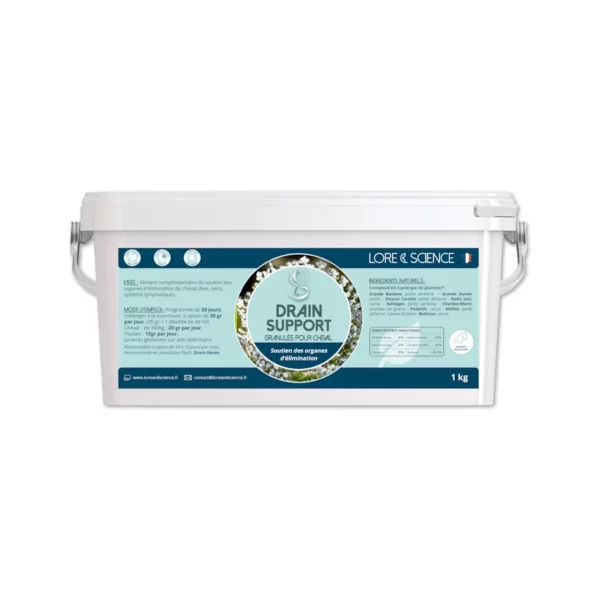Mycoses, infections caused by microscopic fungi that are ubiquitous in the environment, pose a real health problem for horses. These fungal infections mainly affect the skin and hooves of equines, but can also invade the respiratory tract, although the latter form is rarer. In this article, Lore & Science presents a detailed overview of fungal infections in horses.
Understanding mycosis in horses
Mycoses are infections caused by microscopic fungi, often present in the environment. Environmental conditions therefore play a decisive role in their development. Unventilated stables, constantly damp floors and dirty bedding create ideal conditions for the proliferation of fungi. For example, a horse living in a stable where bedding is rarely changed is much more likely to develop fork rot. Add to this an immune system weakened by stress, inadequate nutrition or pre-existing diseases, and the animal's vulnerability to fungal attack increases considerably.
The most common types of fungal infection
Fungal infections in horses come in many forms, each with its own particularities and specific pathogens. Dermatophytosis, commonly known as ringworm, is one of the most common and contagious fungal infections. Dermatophytes Trichophyton equinum and Microsporum gypseum are the usual culprits. The condition is characterized by circular patches of falling hair, often accompanied by scaling and itching. Horses with ringworm can also transmit the infection to other horses, and even to humans, making this mycosis a particular concern in stables.
Another common form of mycosis in horses is fork rot, which affects the hooves. It's usually caused by a combination of fungi and bacteria, and thrives in damp, poorly maintained environments. Symptoms take the form of malodorous necrosis of the fork, often accompanied by lameness due to pain.
Although less common, respiratory mycosis can also affect horses. It is often caused by fungi of the Aspergillus spp. genus, and can lead to serious health problems. Affected horses may show signs of respiratory distress, persistent coughing and abnormal nasal discharge. Avoiding dusty environments and well-ventilated stables are important preventive measures to minimize the risk of this rare but serious infection.
How to treat fungus in horses
First of all, if you suspect a fungal infection in your horse, isolate it and call in your regular veterinarian. This will prevent the infection spreading to the whole stable. The treatment then prescribed will depend on the type of fungus and the severity of the situation.
Local care for mycosis
To effectively combat mycosis in horses, local care plays a crucial role. Antifungal shampoos and ointments, particularly those containing ketoconazole or miconazole, are frequently used to treat dermatophytosis. These specialized products eliminate the fungi present on the skin and prevent the infection from spreading.
In the specific case of fork rot, rigorous daily hoof cleaning is imperative. Using antiseptic solutions and products specially designed for the fork helps to disinfect the affected area and prevent the proliferation of fungi and bacteria. Applying an antifungal balm after cleaning also helps to heal and protect the fork from re-infection. This local care, combined with strict hygiene, is essential to maintain hoof health and avoid painful complications.
Systemic treatments
For severe or extensive mycotic infections, systemic treatments become necessary. Your vet may prescribe oral or injectable antifungals(griseofulvin or itraconazole). These drugs fight the infection from within, reaching the affected areas via the bloodstream. Duration and dosage depend on the severity of the infection and the horse's response to treatment.
Environmental management in the event of fungal infestation
To prevent recurrence of mycosis in horses, it's vital to keep the environment and living environment as clean as possible. Humidity, the main enemy of horses' skin and foot health, must be combated by all possible means: regular , thorough cleaning of stables to eliminate any accumulation of urine and other organic debris, well-drained floors to prevent the build-up of water and stagnant humidity, frequent bedding changes, and good ventilation of living spaces.
How to prevent horse fungus?
To avoid a return of fungal infections, or to support your horse's immune system after a fungal infection, we recommend paying particular attention to his diet. As always, the latter plays a key role in your horse's well-being and good daily health. To support the body after a mycotic infection, it's also possible to supplement your animal's diet naturally, using plants and essential oils found in food supplements such as Fongiless.
Finally, whether your companion is prone to these problems or not, we recommend regular vigilance and inspection to detect any mycosis as early as possible. The sooner these are treated, the better they'll heal, and the more you'll be able to save your stable from a troublesome spread. In case of doubt, never hesitate to consult a veterinarian, who will be able to guide you and provide you with the right treatment for each situation. Vigilance and prevention are the best weapons against fungal infections in horses.
Share your experience or questions with us in the comments ↓

















2 réactions sur "Mycose et champignons chez le cheval, guide complet" (French only)
Hello,
Is Fongiless effective on deep fork rots that are recalcitrant to ALL products already tested externally?
Best regards
Hi Gaelle, are you sure the problem is fungal?